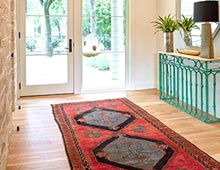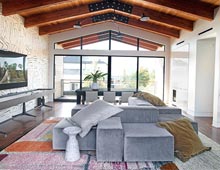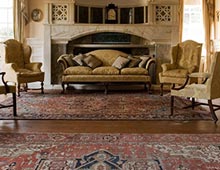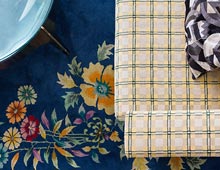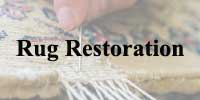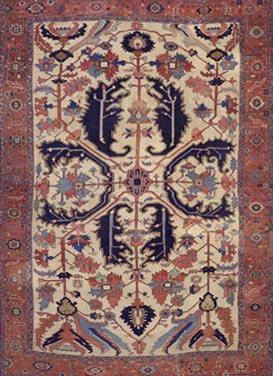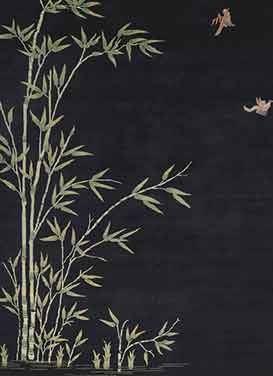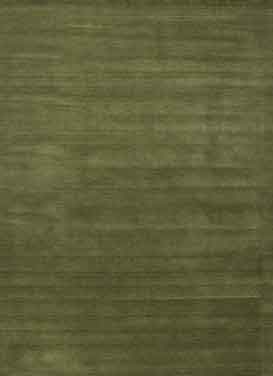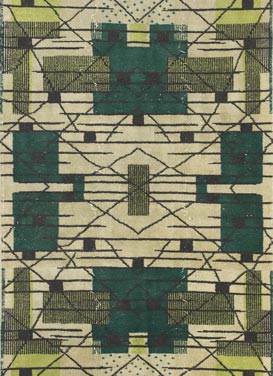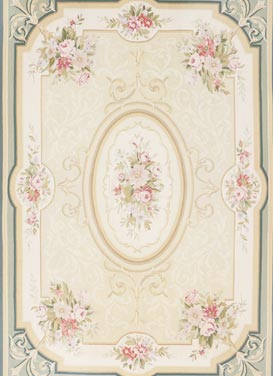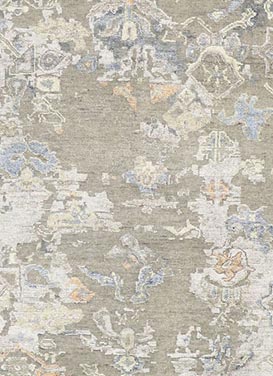Pakistani Rugs


Vintage Pakistani Hand-knotted Rugs
In the realm of vintage rugs, Pakistani rugs stand out as exquisite pieces that seamlessly blend sophisticated patterns with subtly rich colors. These rugs have become highly sought-after in the showroom rug industry, thanks to their ability to enhance the ambiance of any room, whether it's a traditional, transitional, or eclectic space. Among the most cherished styles of Pakistani rugs are the Peshawar rugs, known for their sophisticated designs, intricate compositions, and soft, varied color palettes. The Peshawar region has gained fame for its production of tribal Chobi rugs and rugs featuring Mughal-style patterns and Persian arabesques. What sets Peshawar rugs apart is the natural abrash (color variation) and the use of vegetable dyes, adding distinct character to these rugs. Discover the timeless elegance of Pakistani rugs at Esmaili Rugs.
Exceptional Pakistani Carpets & Rugs Delight the Senses
Discover the world of Pakistani rugs and carpets, where craftsmanship and creativity converge to create exquisite pieces that delight the senses. Each of the following headings introduces a distinct facet of Pakistani rug artistry:
Bokhara: Bokhara rugs are characterized by their distinctive geometric patterns, including rows of octagonal guls (medallions) and intricate border designs. These rugs often feature a rich red or burgundy color palette and are known for their timeless appeal.
Modern / Contemporary / Transitional: Pakistani rug artisans have embraced modern and contemporary design trends, offering rugs that cater to a wide range of interior aesthetics. From minimalist designs to transitional pieces that bridge tradition and modernity, these rugs are a testament to the adaptability of Pakistani craftsmanship.
Tribal / Geometric / Floral: Tribal rugs reflect the nomadic heritage of Pakistan's indigenous people, featuring bold geometric patterns and vibrant colors. In contrast, floral designs evoke the beauty of nature, with intricate blossoms and vines woven into the fabric of these rugs.
Persian / Oushak: Pakistani weavers have mastered the art of creating Persian-style rugs, characterized by intricate floral motifs and finely detailed patterns. Oushak rugs, inspired by Turkish designs, are known for their soft color palettes and timeless elegance.
Moroccan / Swedish: Pakistani rug makers have embraced the global fascination with Moroccan and Swedish design aesthetics. These rugs feature simple yet striking patterns, often in neutral tones, making them versatile additions to contemporary interiors.
Khotan: Khotan rugs hail from the ancient Silk Road city of Khotan and are known for their unique blend of Persian, Chinese, and Central Asian design elements. These rugs often feature medallion patterns and a subdued color palette, making them prized collector's items.
Explore our diverse collection of Pakistani rugs at Esmaili Rugs and immerse yourself in the artistry and heritage that each of these rug styles represents.
10 Things to know about Pakistani Rugs
Pakistani rugs, often referred to as Pakistani carpets or Pakistani hand-knotted rugs, are renowned for their exquisite craftsmanship, intricate designs, and vibrant colors. Here's some key information about Pakistani rugs:
- Historical Significance: Pakistan has a rich history of rug-making that dates back centuries. The tradition of weaving rugs in the region can be traced to various influences, including Persian, Central Asian, and indigenous designs.
- Materials: Pakistani rugs are typically made from high-quality materials, with wool and silk being the most common. Wool is often used for the foundation of the rug, while silk is used for creating intricate patterns and adding a luxurious sheen.
- Weaving Techniques: Pakistani rugs are hand-knotted, a labor-intensive process that involves skilled artisans tying individual knots to create the rug's pile. This technique allows for intricate and detailed designs.
- Designs and Patterns: Pakistani rugs are known for their diverse range of designs and patterns. Traditional motifs often include floral patterns, geometric shapes, and intricate medallions. Many designs are inspired by the rich cultural heritage of Pakistan, including Mughal, Persian, and tribal influences.
- Colors: Pakistani rugs are famous for their vibrant and harmonious color palettes. Artisans use natural dyes to achieve a wide range of colors, from rich reds and blues to soft pastels.
- Quality and Durability: Pakistani rugs are celebrated for their exceptional quality and durability. Skilled weavers ensure that these rugs can withstand daily wear and tear and can last for generations with proper care.
- Regional Variations: Pakistan has several rug-producing regions, each with its own distinctive style and characteristics. Some of the most well-known rug-producing areas include Lahore, Karachi, Peshawar, and Quetta.
- Sizes and Shapes: Pakistani rugs come in various sizes and shapes, including small area rugs, runners, and large room-sized carpets. The shape can vary from rectangular to square or even round, depending on the design and purpose.
- Value and Investment: High-quality Pakistani rugs are considered valuable and are often regarded as investments. Collectors and rug enthusiasts worldwide appreciate their beauty and craftsmanship.
- Export and Trade: Pakistani rugs are exported globally and are an important part of Pakistan's handicraft industry. They are sold in international markets and often carry the stamp of quality associated with the region.
Pakistani Rugs and Carpets: Unveiling the Artistry
Pakistani rugs and carpets are celebrated worldwide for their exceptional quality, exquisite beauty, and timeless appeal. These handcrafted masterpieces are among the finest handmade carpets globally, meticulously fashioned using high-quality wool and boasting intricate designs inspired by traditional motifs and symbols. Our exploration of Pakistani rugs will take you through their various styles, their rich history, and the unique characteristics that set them apart.
A Tapestry of Pakistani Rug History
The history of Pakistani rugs is deeply rooted in the country's cultural heritage and ancient weaving traditions. The art of carpet weaving in Pakistan dates back centuries, with evidence of its existence even during the Mughal Empire. During this illustrious era, carpets were crafted for the imperial court, featuring opulent designs mirroring the grandeur of the time. Skilled artisans also wove carpets for the general populace, incorporating local culture and traditions into their designs, often showcasing intricate floral and geometric motifs.
The British colonial period injected new life into Pakistani carpet weaving, introducing innovative materials and techniques. New designs and patterns were integrated into traditional weaving styles. After the partition of India and Pakistan in 1947, carpet weaving emerged as a vital industry in Pakistan. The nation now stands as one of the world's largest producers and exporters of handmade carpets, with distinct regional styles originating from Lahore, Peshawar, and Karachi. Pakistani carpets are renowned for their vivid colors, intricate patterns, and enduring quality.
Despite challenges from machine-made carpets and evolving tastes, Pakistan's carpet industry continues to thrive, preserving its cultural heritage and craftsmanship. These carpets are prized for several qualities that make them truly exceptional:
- Handmade Craftsmanship: Pakistani rugs and carpets are predominantly handcrafted, with skilled artisans employing traditional techniques to create intricate patterns and designs.
- Premium Materials: High-quality wool, silk, and cotton are the materials of choice for crafting Pakistani carpets. Local wool from native sheep and imported silk from China are meticulously selected to ensure durability and beauty.
- Vibrant Hues: Pakistani carpets are renowned for their vibrant, long-lasting colors achieved through the use of natural dyes. These rich and deep hues retain their brilliance over time.
- Intricate Designs: Characterized by intricate patterns, often featuring floral or geometric motifs, Pakistani carpets are meticulously created by knotted wool or silk onto a cotton base, each knot tied by hand.
- Exceptional Durability: Thanks to their high-quality materials and expert craftsmanship, Pakistani carpets can withstand years of regular use and foot traffic, making them enduring investments.
- Versatility: Available in a wide range of sizes, designs, and colors, Pakistani carpets seamlessly complement various spaces and styles, adding an elegant touch to any interior.
Pakistani Kilim Rugs: Versatile and Timeless Elegance
The first thing that strikes you when you encounter a handwoven Dhurrie or Pakistani kilim rug is the unique visual appeal. Unlike traditional Oriental carpets that are crafted by knotting weft fibers around the warp using a loom, flatweave rugs are made without a warp. This unique technique results in a thinner, more compact structure that's remarkably light and durable. While the traditional format is square, rectangular, and even large Pakistan kilim rugs are not uncommon. In this exploration of kilim rugs and Dhurrie carpets from Pakistan, we'll uncover the intricate details of what makes them so special and why you should consider them for your home.
A Kaleidoscope of Pakistani Rug Styles
Pakistani rugs come in a diverse array of styles, each offering a unique perspective on craftsmanship and aesthetics:
Bokhara Carpet Style Pakistani Rugs
Known for their symmetrical knotting, bold geometric patterns, and rich red or burgundy colors, Bokhara carpets hail from the city of Peshawar and draw inspiration from traditional Turkmen designs.
Chobi Carpet Style Pakistani Rugs
Named "Chobi," meaning "wood" in Urdu, these carpets use natural vegetable dyes, showcasing muted, earthy tones. Typically produced near the Pakistan-Afghanistan border, Chobi designs reflect traditional Persian and Turkish styles.
Oushak Carpet Style Pakistani Rugs
Crafted in Peshawar, these carpets feature geometric allover patterns in soft colors and modern designs in bold colors. They pay homage to traditional Oushak designs.
Persian Carpet Style Pakistani Rugs
Crafted in Lahore, these carpets feature intricate floral and geometric motifs achieved through high knot counts and premium wool. They pay homage to traditional Persian designs.
Kashmiri Carpet Style Pakistani Rugs
Produced in Srinagar (Indian-administered Kashmir) and Lahore, these carpets boast intricate multicolored designs, often blending floral and paisley motifs with high-quality wool or silk.
Turkmen Carpet Style Pakistani Rugs
Inspired by traditional Turkmen designs, these carpets are produced in Quetta, Balochistan. They stand out with their bright colors, bold geometric patterns, and a blend of wool and silk.
Flatweave Kilim Style Pakistani Rugs
Known for their pileless structure, bold geometric designs, and rich colors, Kilim rugs are lightweight and recognizable for their thin and flat profile.
These represent just a glimpse into the world of Pakistani rugs, each a testament to the country's rich tradition of craftsmanship and artistic expression.
Frequently Asked Questions about Pakistani Rugs
Are Pakistani rugs good quality?
Indeed, Pakistani rugs are renowned for their exceptional quality. These handcrafted treasures are considered among the world's finest handmade carpets. Crafted using high-quality materials and traditional techniques, Pakistani rugs are prized for their beauty, durability, and cultural significance.
What are rugs from Pakistan called?
Rugs from Pakistan are commonly referred to as Pakistani rugs or Pakistani carpets. They encompass various styles, including Bokhara rugs, Chobi rugs, Persian-style rugs, and more.
What are three different types of Pakistani rugs?
Three common types of Pakistani rugs are Mori rugs (including Bokhara, Jaldar, and Caucasian designs), Chobi rugs (known for natural dyes and earthy tones), and Persian-style rugs (inspired by traditional Persian motifs).
Are Pakistani rugs Persian?
Pakistani rugs are distinct from Persian rugs, although some Pakistani styles, such as Kashan, Kirman, Mahal, and Sultanabad, draw inspiration from traditional Persian designs. These are often referred to as Pak Persian Rugs or Sootri (Wool) Rugs.
Applied Filters
–
- 1
- 16
–
- 2
- 22
-
-
No items found matching the search criteria
-
-
No items found matching the search criteria
-
-
No items found matching the search criteria
-
-
-
No items found matching the search criteria
Dimensions
–
- 1
- 16
–
- 2
- 22
-
-
No items found matching the search criteria
-
-
No items found matching the search criteria
-
-
No items found matching the search criteria
-
-
-
No items found matching the search criteria

